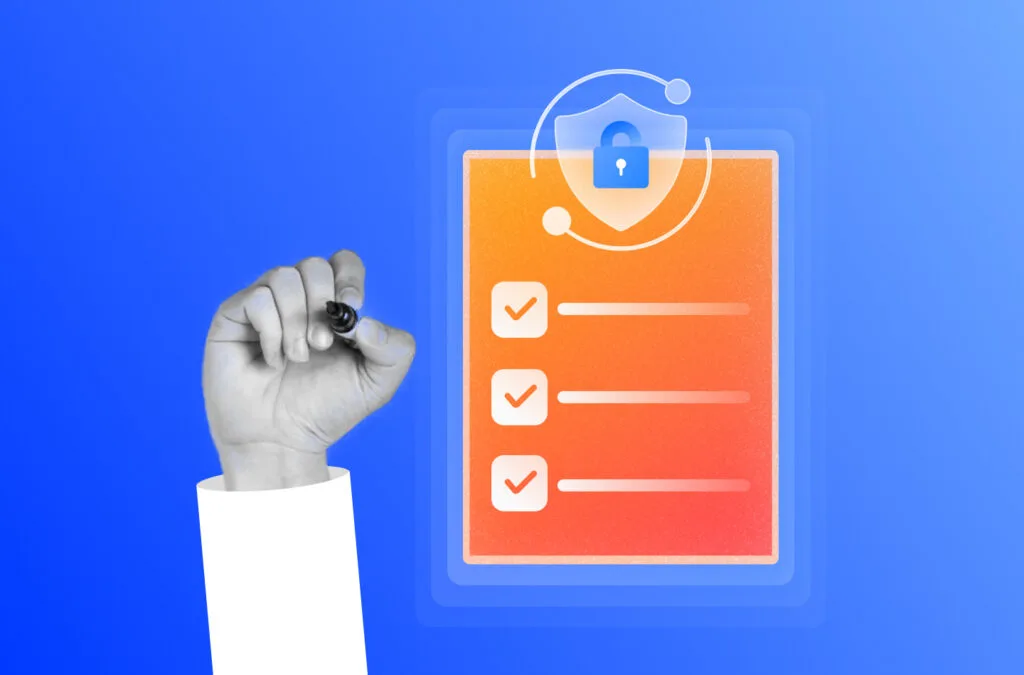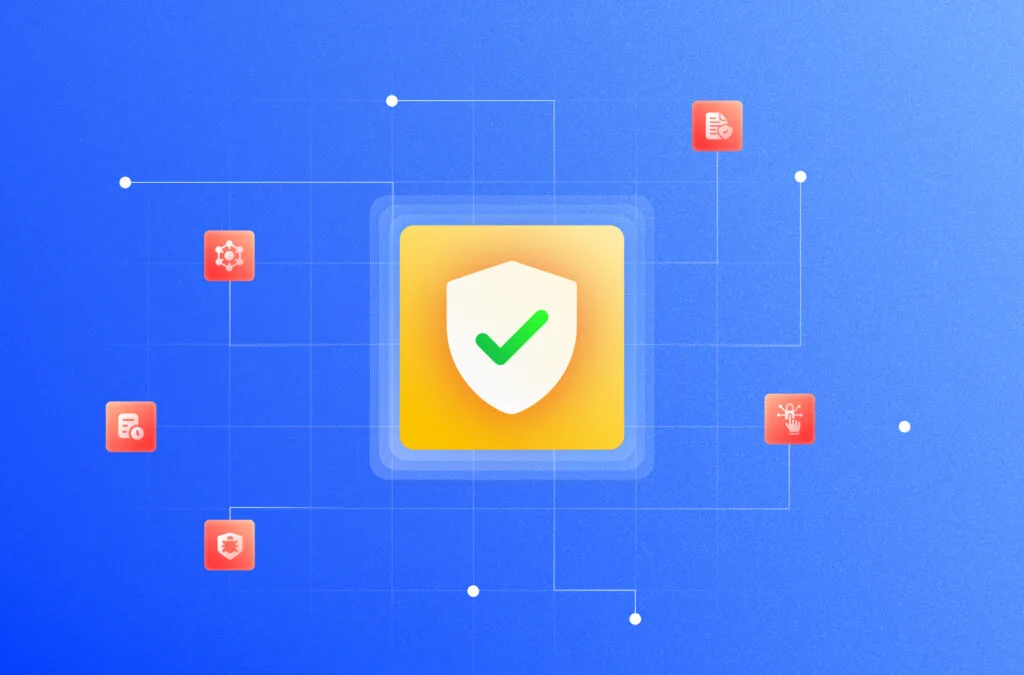Safeguarding your organization against increasingly sophisticated cyber attacks can be daunting. The ever-evolving landscape of cyber threats only compounds the challenges cybersecurity leaders face today. The sheer volume of vulnerabilities and the rapid pace of technological change means they face many variables to deal with.
And so, many leaders face a critical question—where to begin? Even seasoned professionals can feel overwhelmed and uncertain about cybersecurity without a clear, expert-driven roadmap.
To address such problems, we have designed a 50-point cybersecurity checklist to help your organization evaluate its current practices and identify existing weaknesses. It will help you identify critical areas that need your attention, fix gaps, and implement a strong cybersecurity plan.
Why do you need a cybersecurity checklist?
A cybersecurity checklist helps you identify and evaluate misconfigurations, strengthen access control, and ensure your systems can identify and take appropriate action when security incidents occur.
Adhering to the checklist helps organizations form the basis for complying with the best practices required by regulatory standards like ISO, SOC 2, etc. It also improves their security infrastructure by highlighting instances of non-compliance and areas for improvement.
The other benefits of using the checklist are:
- Provides actionable items: Each section contains specific questions or statements that organizations can respond to, indicating whether they have implemented certain security measures or practices.
- Acts as an evaluation tool: By responding to each item on the checklist, organizations can assess their current security practices, identify gaps, and prioritize areas for improvement.
- Guides compliance: The checklist provides guidance on best practices and helps organizations comply with industry standards and regulatory requirements.
What should a cybersecurity checklist include?
A comprehensive cybersecurity checklist should cover key areas of digital security, access control, data encryption, software updates, employee training, incident response planning, and compliance with relevant regulations. It should address both technical and human aspects of cybersecurity to protect against all kinds of cyber threats.
Some of the most important components of a cybersecurity checklist include:
- Management: Focuses on the creation and enforcement of security policies, asset inventory, and executive support for cybersecurity initiatives.
- Information technology staff: Addresses configuration and patch management, operational management, and security testing practices.
- End users: Covers the use of anti-virus software, secure email and internet practices, and data and access management.
- Business continuity: Involves emergency response planning, business resumption planning, and maintaining operational resilience.
- Risk management: Includes risk identification and assessment, control selection, and continuous monitoring of security measures.
- Cyber security policy: Guides the development and enforcement of security policies, defines roles and responsibilities, and manages policy changes.
- Personnel and training: Focuses on employee vetting, security awareness training, and enforcing least privilege access.
- Operational risks: Involves periodic risk assessments, access control, and secure asset management.
For a more comprehensive list of cybersecurity measures and controls, download the full checklist.
Download Your Cybersecurity Checklist
How do you create a cybersecurity checklist?
Creating a cybersecurity checklist should start with gathering the requirements catered to your organization’s specific needs. It should include access controls, network security, data protection, and patch management. It must also include backup strategies to ensure a well-rounded approach to cybersecurity.
The further steps to create a security checklist are:
- Identify assets
Catalog all digital assets, including hardware, software, data, and networks. Include both on-premises and cloud-based resources. Categorize assets by criticality to business operations.
You can refer to ISO 27001 Asset Management guide for more insight on how to identify and manage your assets.
- List potential threats
Enumerate possible cyber threats relevant to your industry and organization. Consider threats like malware, phishing, DDoS attacks, insider threats, and emerging attack vectors. Stay updated on current threat intelligence.
- Assess vulnerabilities
Conduct vulnerability scans and penetration tests to identify weaknesses in your systems. Review configuration settings, patch levels, and access controls. Consider both technical and human vulnerabilities.
Vulnerability assessments have several steps to avoid incidents and comply with regulations. Read in detail about vulnerability management.
- Define security measures
Specify controls to address identified vulnerabilities and mitigate threats. Include technical measures (e.g., firewalls, encryption), procedural controls (e.g., incident response plans), and administrative policies (e.g., user access management).
- Prioritize actions according to risk
Rank security measures based on risk level, implementation cost, and potential impact. Focus on high-risk, high-impact items first. Consider regulatory compliance requirements in your prioritization.
The best option is to make use of a risk register, including a risk matrix so you have a clear view of your organization’s risks in a single location. It must look something like this.
- Create checklist items
Develop clear, actionable checklists with checklist maker for each security measure. Use specific, measurable language. For example: “Ensure all systems are patched within 30 days of release” or “Implement multi-factor authentication for all admin accounts.”
- Review and update regularly
Schedule periodic reviews of your checklist, at least quarterly. Update based on new threats, changing business needs, and lessons learned from security incidents. Involve key stakeholders in the review process.
6 common compliance framework checklists
Common frameworks like HIPAA, NIST, GDPR, etc, provide structured guidelines, standards, and regulations to protect sensitive information and ensure data security.
1. HIPAA compliance checklist
The HIPAA Security Rule specifically focuses on safeguarding electronic PHI (ePHI) by requiring appropriate administrative, physical, and technical safeguards to ensure its confidentiality, integrity, and security.
HIPAA is a mandatory federal law in the United States that applies to healthcare providers. HIPAA violations are taken very seriously in the country, where fines can go up to $250,000.
If you’re in the healthcare industry, it’s essential that you know the requirements of HIPAA. Download the full checklist here.
Download Your HIPAA Checklist
2. NIST controls checklist
NIST frameworks emphasize a risk-based approach to cybersecurity, helping organizations systematically identify, assess, and manage cybersecurity risks. The NIST 800-53 Special Publication provides controls for the privacy and security of information systems.
Download the full NIST 800 53 Controls List.
Download Your NIST 800-53 Controls List
3. GDPR cybersecurity audit checklist
GDPR is a regulation that aims to protect the privacy and personal data of individuals within the European Union. It sets stringent requirements for data protection, affecting organizations worldwide that handle EU residents’ data.
GDPR applies to all businesses that want to conduct business in the European region, regardless if they are based out of there or not. It also applies to small businesses that may not have a physical presence as long as they collect personal data in the EU.
Here’s a GDPR audit checklist:
Download Your GDPR Audit Checklist
4. ISO 27001 audit checklist
ISO 27001 is an internationally recognized information security standard. It helps companies to protect their information security management systems or ISMS. It includes risk management and continuous control monitoring for enhanced privacy.
ISO 27001’s guiding principles include confidentiality, integrity, and availability. It applies to all organizations that want a secure framework for protecting information assets. It is common among SaaS providers to deal with customer information.
The following ISO 27001 audit checklist will help you understand your stance in terms of information security:
Download Your ISO 27001 Audit Checklist
5. PCI DSS compliance checklist
PCI DSS, or Payment Card Industry Data Security Standard, provides guidelines for data security for companies that handle credit card information or other payment information. It lays down the requirements of policies regarding cardholder information.
PCI DSS applies to businesses that collect, store, process or transfer cardholder data. If you operate as a merchant handling payment cards, you are required to adhere to its guidelines.
To understand the PCI requirements better, download the complete checklist:
Download Your PCI Compliance Checklist
6. SOC 2 checklist
SOC 2 (System and organization controls) is a voluntary compliance standard that details guidelines on how organizations must handle customer information. Its trust service criteria are confidentiality, privacy, security, processing integrity, and availability.
SOC 2 applies to organizations that store and process customer information on the cloud. Customers, third parties, and other businesses often request a SOC 2 report to ensure that your company follows proper data security guidelines.
Understand the guidelines of SOC 2 better with the following checklist:
Download Your SOC 2 Compliance Checklist
Monitor cybersecurity checks constantly
Even with a checklist in hand, the manual process can be resource-heavy and time-consuming. It occupies cybersecurity teams with routine tasks rather than allowing them to focus on business-critical activities. Additionally, continuous control monitoring presents significant challenges.
An efficient way to curb this problem would be to adopt a GRC (Governance, risk, and compliance) automation tool. It will not only monitor your cybersecurity stance constantly but also alert you in case of any breaches or control failure.
One of the top choices for GRC automation is Sprinto. It is an easy-to-use software designed especially for cybersecurity. It provides 24/7 security control monitoring and simplifies compliance management, allowing you to focus on business growth.
Sprinto integrates with your cloud environment to consolidate risk, map controls, and automated checks. Its top 3 features include:
1. Security training: You can conduct training programs necessary for cybersec within the platform. It lets you publish and manage training for employees while tracking the completion rate.
2. Vulnerability management: Run periodic vulnerability scans in Sprinto to assess your system for any gaps. These can also be scheduled ahead of time and can provide reactive fixes.
3. Incident management: The platform alerts you incase of any incidents and allows you to escalate events for prompt action. You can manage the incident lifecycle in the platform for better documentation and to prevent future occurrences.
For instance, HubEngage needed to demonstrate compliance with ISO 27001, SOC 2, GDPR, and HIPAA to ensure data security and trust for their clients. They had complex compliance requirements with high resource allocation needs.
HubEngage initially partnered with Sprinto to implement ISO 27001 compliance. With 90% of controls already in place, they further went on to implement GDPR, HIPAA, and SOC 2 Type 1.
Sunil Sarda, Head of Engineering at HubEngage remarks
“When you know everything is connected, and 3000-4000 checks are happening automatically, hitting that 95% compliance mark is easy”
Frequently Asked Questions
1. What is a cybersecurity checklist?
A cybersecurity checklist is a list of action items that help security teams check and align their controls and internal policies with security best practices and compliance requirements. It provides guidance on the protection of an organization’s information systems and critical data from cyber threats.
2. What is a security audit checklist?
A security audit checklist is a comprehensive list of items to evaluate an organization’s security posture. It typically includes:
- Asset inventory
- Access controls
- Network security
- Data protection
- Physical security
- Incident response plans
- Compliance requirements
- Employee training
- Vendor management
- Security policies and procedures
3. What are some common cybersecurity risks?
Some of the most common cybersecurity risks include:
- Phishing attacks
- Malware infections
- Data breaches
- Ransomware
- Insider threats
4. How to conduct a cybersecurity assessment?
A cybersecurity assessment is a systematic process to evaluate an organization’s security posture. It starts with defining scope and objectives, then gathering information and identifying assets and vulnerabilities. Assessors analyze threats, test controls, and evaluate results.
5. What are the five C’s of cybersecurity?
The five C’s of cybersecurity are:
- Change: Adapting to evolving threats
- Compliance: Meeting regulatory requirements
- Cost: Balancing security investments
- Continuity: Ensuring business operations
- Coverage: Comprehensive protection across systems
Pansy
Pansy is an ISC2 Certified in Cybersecurity content marketer with a background in Computer Science engineering. Lately, she has been exploring the world of marketing through the lens of GRC (Governance, risk & compliance) with Sprinto. When she’s not working, she’s either deeply engrossed in political fiction or honing her culinary skills. You may also find her sunbathing on a beach or hiking through a dense forest.
Explore more
research & insights curated to help you earn a seat at the table.
























